-
Paper Information
- Previous Paper
- Paper Submission
-
Journal Information
- About This Journal
- Editorial Board
- Current Issue
- Archive
- Author Guidelines
- Contact Us
Geosciences
p-ISSN: 2163-1697 e-ISSN: 2163-1719
2013; 3(4): 108-118
doi:10.5923/j.geo.20130304.02
Petroliferous Basins and Shale Gas - An Unconventional Hydrocarbon Asset of India
Syed Zaheer Hasan1, M. Y. Farooqui2, PH Rao1, K. Ramachandran1, Pushpita Tripathy3, T. Harinarayana1
1Gujarat Energy Research and Management Institute, Gandhinagar, Gujarat, India
2Gujarat State Petroleum Corporation Limited, Gandhinagar, Gujarat, India
3Department of Geology, IIT Roorkee, Uttarakhand, India
Correspondence to: Syed Zaheer Hasan, Gujarat Energy Research and Management Institute, Gandhinagar, Gujarat, India.
| Email: |  |
Copyright © 2012 Scientific & Academic Publishing. All Rights Reserved.
There are many major assets of hydrocarbon potential that are distributed all over India. The Brahmaputra valley of NE India, the Cambay region of Gujarat coast, the west coast offshore and the east coast offshore regions are the major assets from where the maximum hydrocarbon production is being tapped. The offshore regions have share around two-third and the rest is shared by the onshore regions. The average annual production of crude oil is close to 35MMT and gas is 32BCF which in total is far behind the projected demand which may increase many fold by the end of this decade. This increase in demand leaves no option except to explore vigorously for the unconventional resources namely Coal Bed Methane, Tight reservoirs, Shale Gas, Underground Coal Gasification, Gas Hydrates etc. Except the Coal Bed Methane and the Shale Gas the knowledge and efforts towards other alternate resources are in embryonic stage. The present study highlights the importance of Shale Gas in filling the gap between demand and supply as a model in Cambay Basin.
Keywords: Unconventional Hydrocarbon Resource, Coal Bed Methane, Gas Hydrates, Shale Gas, Underground Coal Gasification, Tight Reservoirs
Cite this paper: Syed Zaheer Hasan, M. Y. Farooqui, PH Rao, K. Ramachandran, Pushpita Tripathy, T. Harinarayana, Petroliferous Basins and Shale Gas - An Unconventional Hydrocarbon Asset of India, Geosciences, Vol. 3 No. 4, 2013, pp. 108-118. doi: 10.5923/j.geo.20130304.02.
Article Outline
1. Introduction
- India has a diversified geological system wherein; it contains rocks covering almost the entire spectrum of the Geological Time Scale (Figure-1). Sedimentary basins of India are evolved through different geological ages, by different processes. The country has vast sedimentary cover both onshore and offshore. With an areal extent of about 3.14 million sq. km, a total of 26 sedimentary basins have been identified and categorized depending upon the degrees of hydrocarbon prospectivity. Based on the exploration carried out so far and status of knowledge in terms of occurrence of hydrocarbons, sedimentary basins of India are divided into four categories (Figure-2), the proven commercial productivity; the identified prospectivity; the prospective; and the potentially prospective basins.The study is based on the hydrocarbon resources of Indian petroliferous basins and the role of unconventional hydrocarbons as an alternative to the conventional resource in future. To meet the rapidly increasing demand for fossil fuels, especially the hydrocarbon based energy resources and faster depletion of conventional energy resources, the unconventional hydrocarbon resources are the only option left to create a balance between demand and supply and a step ahead towards sustainability. Apart from other discovered and undiscovered resources, the shale gas along with the CBM will play one of the most important roles in the days ahead.
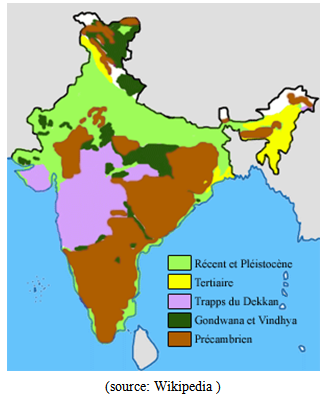 | Figure 1. Geological map of India[19] |
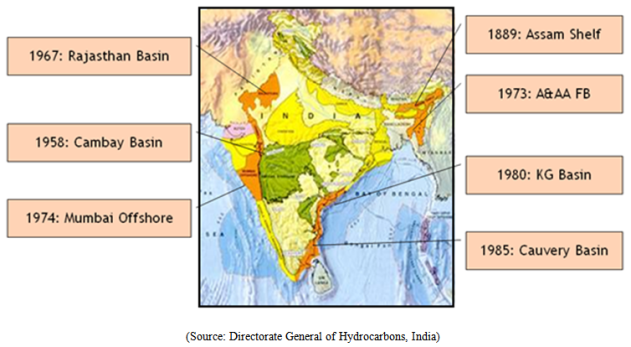 | Figure 2. Petroliferous basins of India[20] |
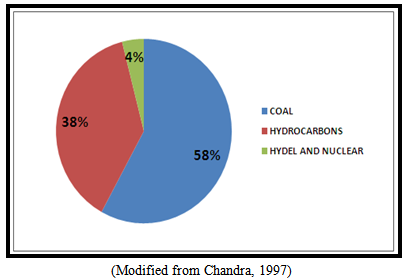 | Figure 3. Energy scenario of India[1] |
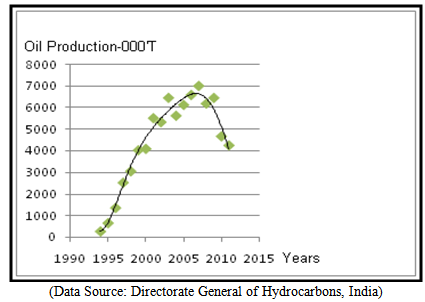 | Figure 4. Oil Production in India[20] |
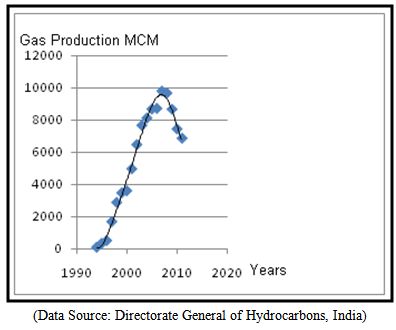 | Figure 5. Gas Production in India[20] |
2. Unconventional Hydrocarbon Resource
- All natural resources are distributed log normally in nature (Figure 6 and 7) describing the sense that as we go deeper into the gas-resource triangle, the reservoirs are lower grade. This usually means the reservoir permeability is decreasing. These low-permeability reservoirs are much larger in size than the high-quality reservoirs[6]. The common theme is that low-quality deposits of natural gas require improved technology and adequate gas prices before they can be developed and produced economically.Unconventional hydrocarbons are the sources that mainly include tight gas sand; coal bed methane; shale gas; gas hydrate; and underground coal gasification. They require methods for extraction which are not normally necessary in the conventional extraction. They are traditionally known for their low permeability. The faster depletion of conventional resources vis-à-vis rapidly increasing demands from various sectors, India along with other countries have started exploring the alternatives to conventional energy. Only one third of worldwide hydrocarbon reserves are conventional, the remaining sources are unconventional (Figure 8).Shale gas is a natural gas formed and trapped within the shale formation that typically functions as the reservoir, source rock and the seal. . Its evolutionary history over the globe (figure 9) and its accumulation in India (Figure 10) highlights the huge prospects of further exploration and sustainable production. The shale gas in Cambay basin is dealt in detail as part of the present study.
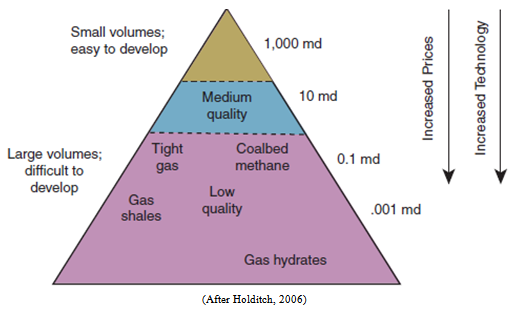 | Figure 6. Resource triangle for natural gas[6] |
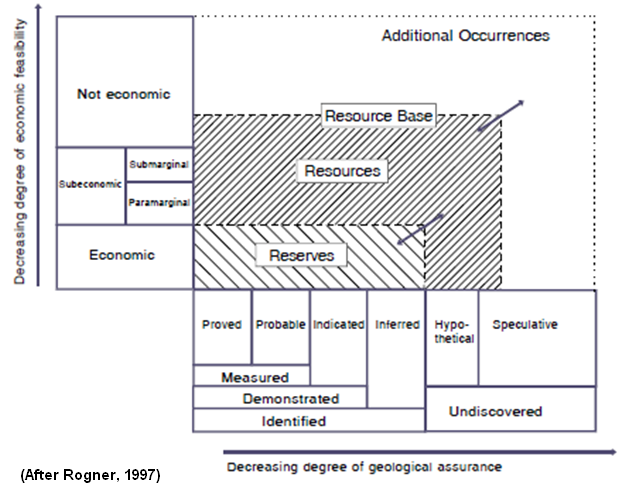 | Figure 7. Classification of energy reserves and resource[21] |
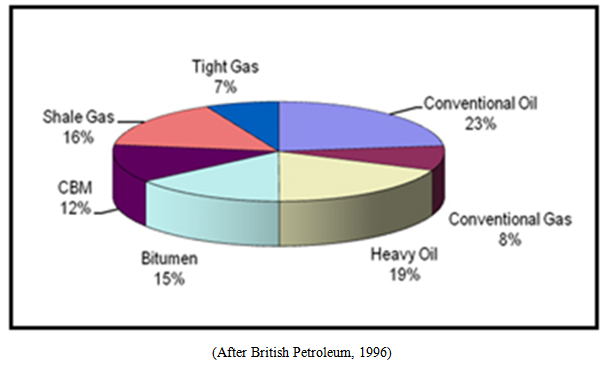 | Figure 8. Worldwide hydrocarbon reserves[22] (After British Petroleum, 1996) |
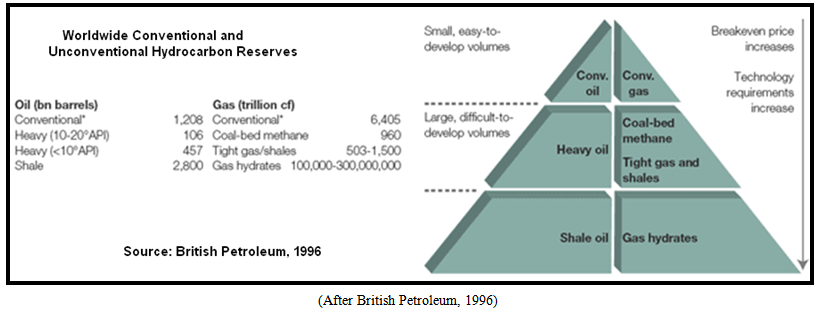 | Figure 9. Shale gas as global resource[22] |
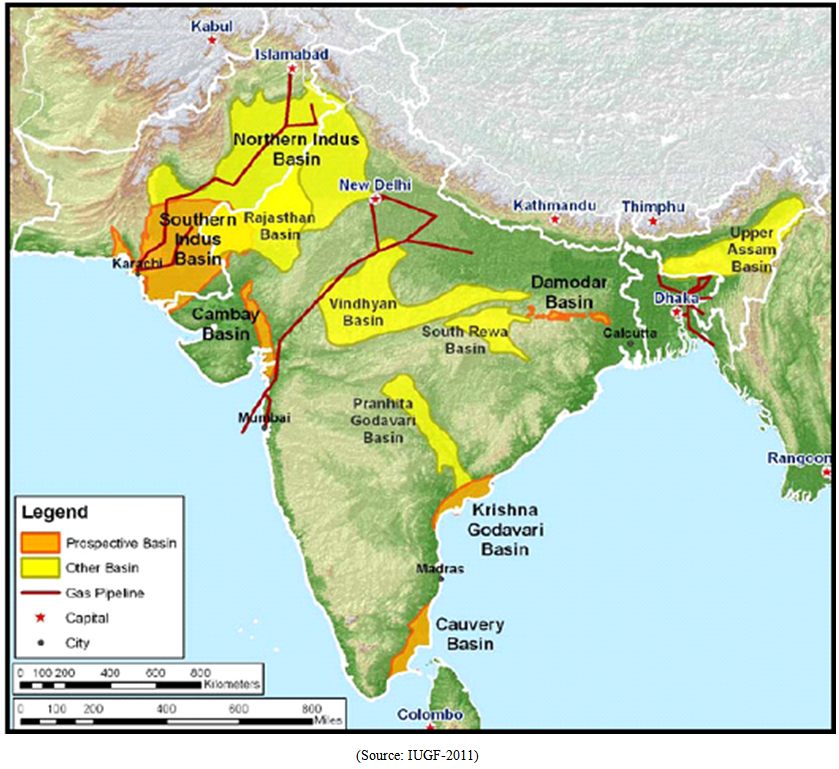 | Figure 10. Potential shale gas basins of India[23] |
3. Shale Gas in Cambay Basin
- The Cambay basin a rich petroleum province of India is a narrow, elongated rift graben, extending from Surat in the south to Sanchor in the north (Figure 11). It began evolving following the extensive outpour of Deccan Basalts during late Cretaceous covering large tracts of western and Central India[7, 8 and 9]. The Cambay rift valley is bounded by well demarcated basin margin step faults. Based on the cross trends, the basin has been divided into five tectonic blocks. From north to south, the blocks are: Sanchor, Ahmadabad, Tarapur, Broach and Narmada.The Early Tertiary sediments ranging in age from Paleocene to Early Eocene represent syn-rift stage of deposition that was controlled by faults and basement highs in an expanding rift system[10]. The Middle Eocene witnessed a regressive phase with oscillating conditions of deposition and development of deltaic sequences in the entire basin[11].Thick Cambay shale has been the main hydrocarbon source rock in the basin wherein the coal developed within the deltaic sequence of other source rocks[12]. The lithological heterogeneity gave rise to permeability barriers, which facilitated entrapment of hydrocarbons (Figure 12). The associated unconformity also helped in the development of secondary porosity.The source rock intervals in the Cambay basin, ranges from early Paleocene to Oligocene in age. The proven reservoirs are dominated by sandstones, siltstones, conglomerates, fractured shales and basalts forming less important reservoir. Shales, ranging from Paleocene to Miocene in age dominate the proven seals in the Cambay basin.The hydrocarbon production trends, (Figure 13 and 14) depict decline during the recent years. In order to overcome the deficient hydrocarbons, exploiting shale gas reserves is the best alternate as they have enormous amount of gas and the larger formations. They can continue to produce at a steady rate for decades[13].
3.1. Methodological Approach
- The essential factors for the development of shale gas reservoirs are the gas content and the recovery rate. Both require the detailed laboratory investigation leading to organic richness and degree of maturity where extremely low permeability leaves no option except to create a dense network of fractures to sustain the production. The time has come to infuse newer technologies that are harmonious with environmental norms and significant towards hydrocarbon value chain leading to energy security and prosperity[14].The approach can be classified as under,A. Field Work1. Identification of prospects for testing the methodologyο Collection of data• Geological, geophysical and geochemical data• Core and reservoir data• Testing details and production data• Review of all available data.B. Laboratory Work1. Detailed core analyses with special reference to-ο Storage and transmissionο Mineral compositionο Chemical behaviour of reservoir rockο Selection of applicable technique2. Well data interpretation3. Detailed structure and fault mapping of pay zones using seismic and well data4. Reservoir characterization using seismic and log data5. Development of Technology for incremental increase in production in varied geological and reservoir conditions.6. Testing the technique in a pilot prospect/wellExpected Outcome1. The result will provide the technologies to adopt for sustainable recovery2. The findings decide the effective future predictions3. The study will be a model for similar field conditions4. Development, enhancement, adoption and absorption of technologySome of the gas produced is held in natural fractures, some in pore spaces, and some is adsorbed onto the organic material. The gas in the fractures can be produced immediately. The gas adsorbed onto organic material is released as the formation pressure is drawn down by the well[15]. The total organic carbon content, matrix porosity and water saturation are the key parameters to have an answer for shale gas potential of any basin. However, there are other elements to be considered for the development of successful shale gas plays (Figure 15). The physico-chemical parameters (Table-1) and stratigraphic pattern together show high end prospects of shale gas accumulation in the basin.The hydraulic fracturing is usually conducted mostly with water based fluids using additives as friction reducer, scale inhibitor and proppants to hold the fractures open[16]. (Kaufman et al 2008). Hence, needs to be addressed along with the environment concern as well[17 and 18].
|
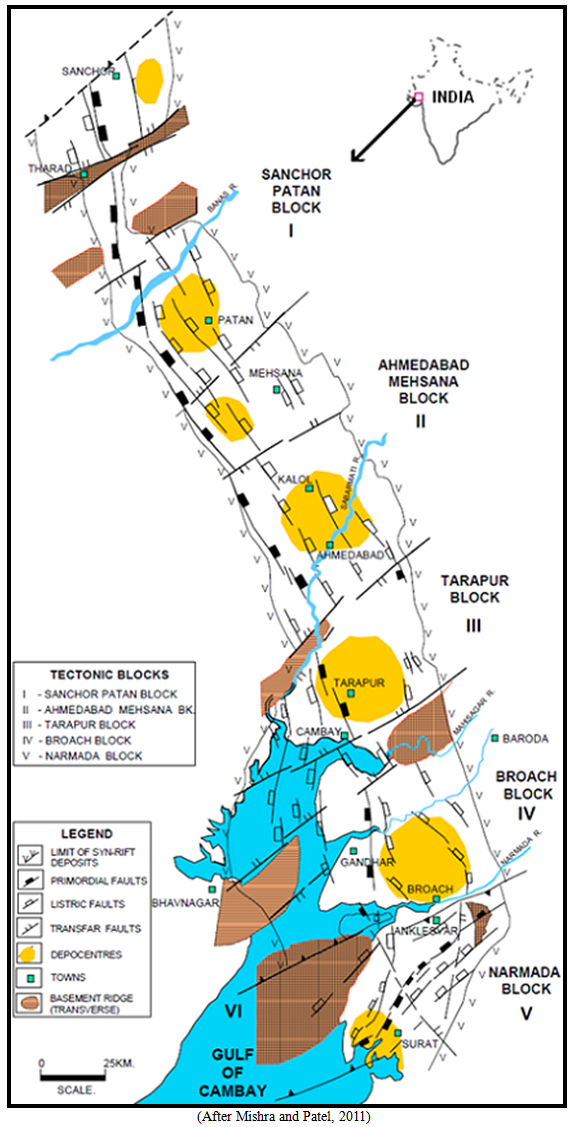 | Figure 11. Tectonic map of Cambay basin[24] |
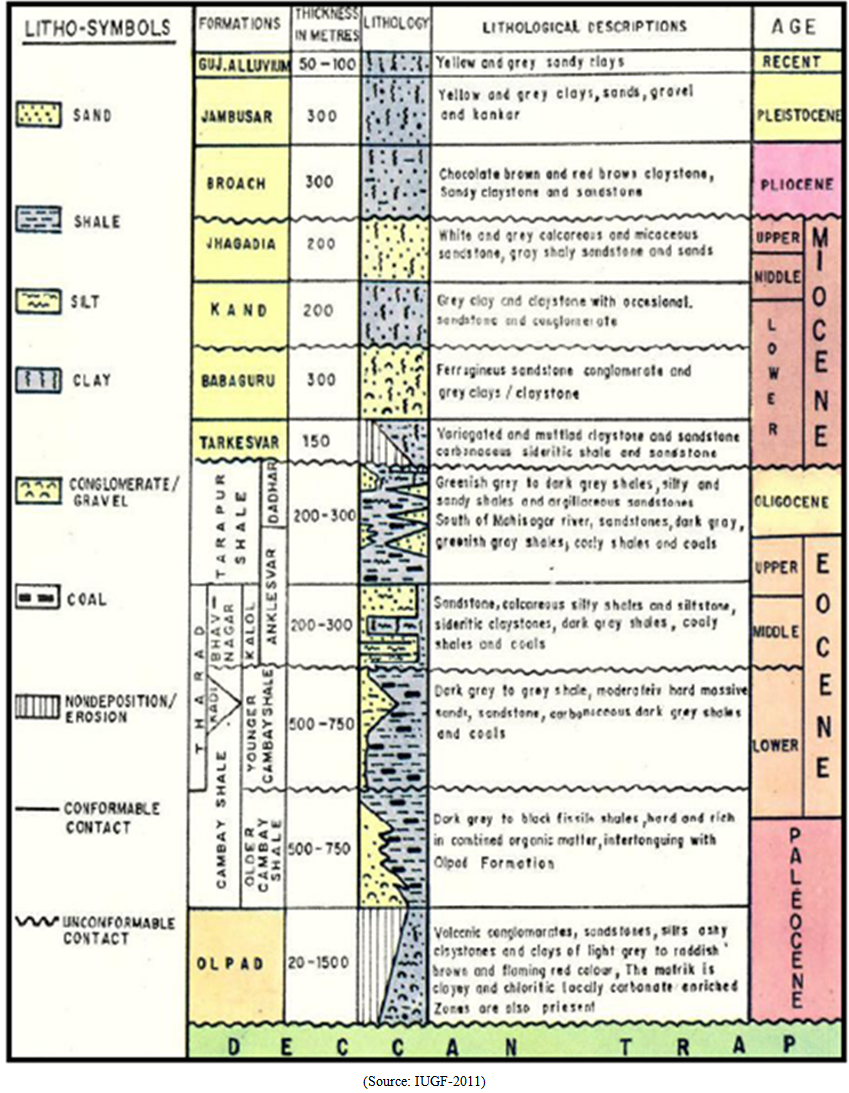 | Figure 12. Shales in stratigraphy in Cambay basin[23] |
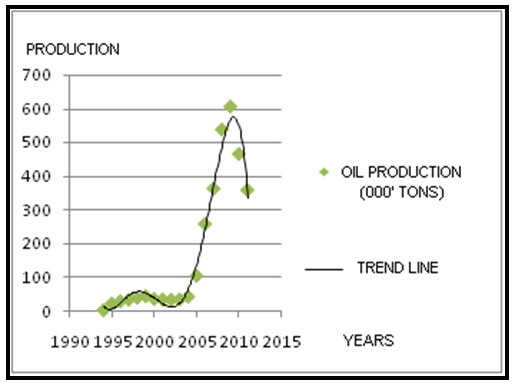 | Figure 13. Oil production and trend in Cambay basin[20] |
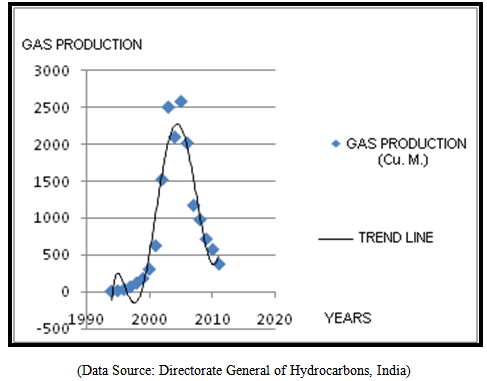 | Figure 14. Gas production and trend in Cambay basin[20] |
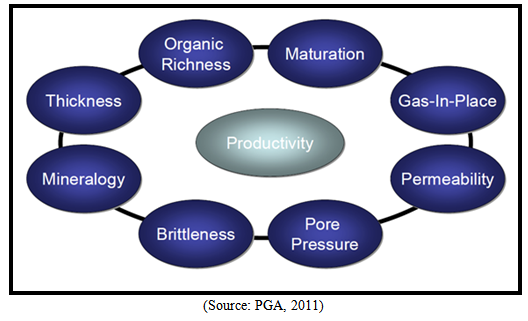 | Figure 15. Elements for the development of successful shale gas play[25] |
4. Conclusions
- The decline in production trends draws attention to step ahead towards the resources which are unconventional but can be sustained with production for decades. The shale gas now become an important part of energy mix that require thorough laboratory investigation followed by controlled hydraulic fracturing to surge in economically sustained recovery.The stratigraphic succession of the Cambay basin is largely influenced together by the tectonic set-up and sedimentary patterns. There exists a vast possibility of unconventional resources especially shale gas as evidenced by previous researches that deserve to enlarge the exploratory horizons with time and space.
ACKNOWLEDGEMENTS
- The authors are highly grateful to the Director of Gujarat Energy Research and Management Institute for providing technical support during the entire course of preparation of this manuscript.
 Abstract
Abstract Reference
Reference Full-Text PDF
Full-Text PDF Full-text HTML
Full-text HTML